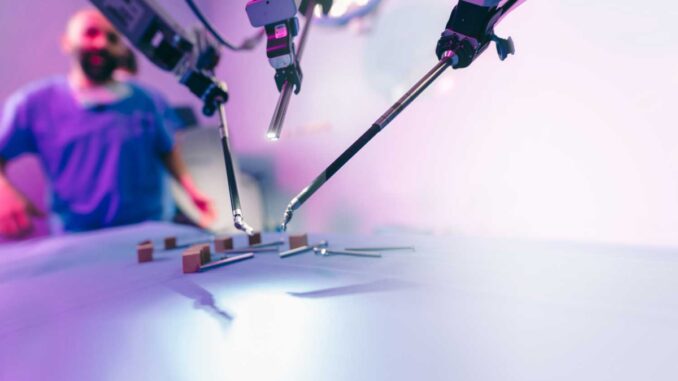
Robotic surgeries are becoming more common and popular in the healthcare sector. They offer many advantages over traditional open surgeries, such as less pain, blood loss, infection risk and scarring. They also enable surgeons to perform complex and delicate procedures with more precision, flexibility and control. In this blog post, we will explore some of the benefits of robotic surgeries and how they are transforming the future of healthcare.
What is robotic surgery?
Robotic surgery, also known as robot-assisted surgery, is a type of minimally invasive surgery that uses specialized technology to assist surgeons in performing various operations. The technology consists of:
– A surgical console where the surgeon sits and controls the movements of the robotic arms and instruments.
– A robotic cart with four arms that hold a camera and surgical tools. The camera provides a magnified 3D view of the surgical site, while the tools mimic the movements of the surgeon’s hands and wrists.
– A monitor that displays the images from the camera and other information for the surgical team.
The surgeon operates the robotic system through a computer interface that translates his or her hand motions into precise movements of the instruments. The surgeon can also adjust the scale of the movements, making them smaller or larger as needed.
What are the benefits of robotic surgery?
Robotic surgery offers many benefits to patients compared to open surgery, including:
– Shorter hospitalization: Robotic surgery usually requires less time in the hospital, as patients recover faster and experience fewer complications.
– Reduced pain and discomfort: Robotic surgery involves smaller incisions and less trauma to the surrounding tissues, which means less pain and inflammation after the surgery.
– Faster recovery time and return to normal activities: Robotic surgery allows patients to resume their daily activities sooner, as they heal faster and have less scarring and restrictions.
– Smaller incisions, resulting in reduced risk of infection: Robotic surgery reduces the exposure of the internal organs to external contaminants, which lowers the chance of infection and other complications.
– Reduced blood loss and transfusions: Robotic surgery minimizes the bleeding during the operation, which reduces the need for blood transfusions and improves patient safety.
– Minimal scarring: Robotic surgery leaves smaller and less noticeable scars on the skin, which improves cosmetic outcomes and patient satisfaction.
Robotic surgery also benefits surgeons by enhancing their capabilities and performance:
– Precision: Robotic surgery allows surgeons to perform delicate and complex procedures with more accuracy and control, as they can manipulate the instruments with greater dexterity and stability.
– Flexibility: Robotic surgery enables surgeons to access hard-to-reach areas and perform maneuvers that are difficult or impossible with conventional techniques, such as suturing or cutting at different angles.
– Control: Robotic surgery gives surgeons more control over the operation, as they can adjust the speed, scale and direction of the movements according to their preferences and needs.
– Vision: Robotic surgery provides surgeons with a high-definition, magnified and 3D view of the surgical site, which improves their visualization and orientation.
– Comfort: Robotic surgery reduces the physical strain and fatigue on surgeons, as they can operate from a comfortable seated position without bending or stretching.
What are some examples of robotic surgeries?
Robotic surgery is suitable for many types of procedures across different specialties. Some examples of robotic surgeries are :
– Heart surgery: Robotic surgery can be used to repair heart defects, remove cardiac tumors, replace or repair heart valves and treat atrial fibrillation.
– Gastrointestinal surgery: Robotic surgery can be used to remove parts or all of the stomach, colon, pancreas or rectum for cancer or other conditions. It can also be used to perform gastric bypass for obesity or reflux disease.
– General surgery: Robotic surgery can be used to remove the appendix, gallbladder or hernia. It can also be used to treat median arcuate ligament syndrome (MALS), a rare condition that causes chronic abdominal pain.
– Gynecologic surgery: Robotic surgery can be used to remove the uterus, ovaries or fallopian tubes for cancer or benign conditions. It can also be used to treat endometriosis, pelvic organ prolapse or uterine fibroids.
– Thoracic surgery: Robotic surgery can be used to remove parts or all of the lung for cancer or other diseases. It can also be used to remove mediastinal masses (tumors in the chest cavity) or thymus gland (a small organ behind the breastbone).
– Urologic surgery: Robotic surgery can be used to remove parts or all of the bladder, kidney or prostate for cancer or benign conditions. It can also be used to perform sural nerve graft, a procedure that restores sensation and function to the penis after prostate removal.
Conclusion
Robotic surgery is a revolutionary technology that offers many benefits to patients and surgeons. It improves the outcomes and quality of life for patients by reducing pain, blood loss, infection risk, scarring and recovery time. It also enhances the capabilities and performance of surgeons by increasing precision, flexibility, control, vision and comfort. Robotic surgery is transforming the future of healthcare by enabling more effective and efficient treatments for various conditions.







Leave a Reply